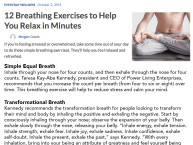
Healthy Waist Management
PWR TIP: Every 34 seconds someone in the U.S. dies of cardiovascular disease. Heart disease is America’s No. 1 killer. Are you nurturing your heart? How knowledgable are you when it comes to your own risk factors? Would you be able to recognize if you were having a heart attack? Would you know what to do?
Heart attacks are not always as dramatic as you see in the movies. Many start with mild pain. You may not realize what is actually wrong until it’s too late, and the symptoms of a heart attack for women may be quite different than those in men. All healing starts with self-awareness, which then allows you to take control. When it comes to your health, knowledge really is power. It’s critical for you to know your family history, as well as your numbers and risk factors. Then, you can create a lifestyle plan to protect your heart. Here are some of the basics:
Know your numbers:
Blood Pressure – Many factors can play a role in your blood pressure from your stress levels to what you eat. If you have high blood pressure, also called hypertension, your heart must work harder to pump blood. Aim for a reading of less than 120/80 mmHg.
Cholesterol – Cholesterol is necessary for building cell membranes. However, when it gets out of balance, problems begin to occur in the body. When it come to Total Cholesterol, aim for less than 200 mg/dL. High levels of LDL (“bad”) cholesterol raise your risk of heart disease because it can build up inside your blood vessels, leading to narrowing and hardening of your arteries. Less than 100 mg/dL of LDL is optimal, whereas 160 to 189 mg/dL is high. HDL (“good”) cholesterol, on the other hand, removes deposits from inside your blood vessels and takes them to the liver for removal. Low levels of HDL cholesterol increase your risk of heart disease so strive for 50 mg/dL or higher.
Triglycerides – These are chains of high-energy fatty acids which provide much of the energy needed for cells to function. High triglycerides have been associated with heart disease, and it is good for the levels to be less than 150 mg/dL.
Fasting Glucose – High glucose levels increase the risk of heart disease. Aim for a fasting glucose of less than 100 mg/dL. Also, note that blood glucose is higher after meals and usually lowest in the morning.
Body Mass Index (BMI) – Being overweight or obese is a risk factor for heart disease. BMI is a measure of your weight relative to your height, and is an indicator of total body fat. A BMI over 25 indicates you are overweight; over 30 indicates you are obese. Note that BMI does not show the difference between fat and muscle, so it does not always accurately predict when weight could lead to health problems – particularly for people who are very short (under 5 feet), older people who have lost muscle mass, or those who have a lot of muscle.
Waist Circumference – Your waist measurement is a clue to predicting insulin sensitivity and determining what’s called central obesity, which are risk factors for heart disease, as well as diabetes. Central obesity means carrying extra weight around the waist, as opposed to the hips. A waist measurement of more than 40 inches for men and more than 35 inches for women means you have central obesity. Your risk of heart disease is higher because abdominal fat can increase the production of LDL (bad) cholesterol, the type of blood fat that can be deposited on the inside of blood vessel walls. To measure your waist, place a tape measure around your bare abdomen just above your hip bone. Be sure that the tape is snug, but does not compress your skin, and is parallel to the floor.
Know the warning signs:
Chest discomfort. Most heart attacks involve discomfort in the center of the chest that lasts more than a few minutes, or that goes away and comes back. It can feel like uncomfortable pressure, squeezing, fullness or pain.
Discomfort in other areas of the upper body. Symptoms can include pain or discomfort in one or both arms, the back, neck, jaw or stomach.
Shortness of breath. This feeling may occur with or without chest discomfort.
Other signs of discomfort. These may include breaking out in a cold sweat, nausea or lightheadedness.
Note: Women are somewhat more likely than men to experience some of the other common symptoms, particularly shortness of breath, nausea/vomiting and back or jaw pain.
If you smoke, quit:
Smoking doubles your risk of getting heart disease. Cigarette smoking is the most important preventable cause of premature death in the United States. In relation to heart disease, smoking increases blood pressure, decreases exercise tolerance and increases the tendency for blood to clot. It also decreases HDL cholesterol.
Get help to quit. If you find it a challenge to quit on your own, seek professional help. There are another of smoking cessation programs which have been successful.
Written by Teresa Kay-Aba Kennedy, Ph.D., MBA. Part of the Power Living® Empowerment Series.
TAKE CONTROL OF YOUR HEALTH: If you want to detoxify your body and get a jumpstart to a healthier life, read the Seven Day-PWR Detox book. If you need help reaching your goals, sign up for a free consultative interview and learn more about our wellness coaching.
Photo Credit: Luigi Diamanti / FreeDigitalPhotos.net
Comments







